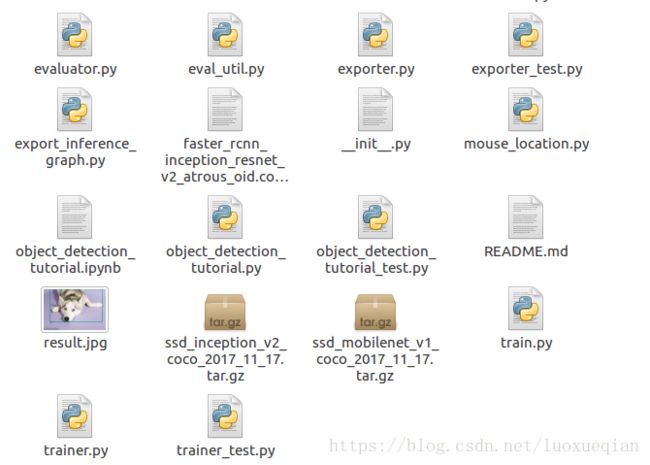TensorFlow目标检测——通过鼠标点击图片即输出label
AI最常见是应用是在图像识别上,即输入一张图像,输出该图像对应的类别。
Google开源了一些TensorFlow Object Detection API,下面以ssd_mobilenet_v1_coco_2017_11_17模型为例,介绍如何在TensorFlow中进行目标检测。
目标检测的代码结构如下:
目标检测的数据集是COCO数据集,包含90种可检测的目标,存储在mscoco_label_map.pbtxt文件中
打开如下:
首先打开模型及label文件
# What model to download.
MODEL_NAME = 'ssd_mobilenet_v1_coco_2017_11_17' #使用模型
MODEL_FILE = MODEL_NAME + '.tar.gz'
#DOWNLOAD_BASE = 'http://download.tensorflow.org/models/object_detection/' 模型下载地址
# Path to frozen detection graph. This is the actual model that is used for the object detection.
PATH_TO_CKPT = MODEL_NAME + '/frozen_inference_graph.pb'
# List of the strings that is used to add correct label for each box.
PATH_TO_LABELS = os.path.join('data', 'mscoco_label_map.pbtxt')
NUM_CLASSES = 90 #识别类型个数
#opener = urllib.request.URLopener()
#opener.retrieve(DOWNLOAD_BASE + MODEL_FILE, MODEL_FILE)
tar_file = tarfile.open(MODEL_FILE)
for file in tar_file.getmembers():
file_name = os.path.basename(file.name)
if 'frozen_inference_graph.pb' in file_name:
tar_file.extract(file, os.getcwd()) #.pb文件为训练出的模型
#load graph
detection_graph = tf.Graph()
with detection_graph.as_default():
od_graph_def = tf.GraphDef()
with tf.gfile.GFile(PATH_TO_CKPT, 'rb') as fid:
serialized_graph = fid.read()
od_graph_def.ParseFromString(serialized_graph)
tf.import_graph_def(od_graph_def, name='')
label_map = label_map_util.load_labelmap(PATH_TO_LABELS) #PATH_TO_LABELS文件中包含90种标签
categories = label_map_util.convert_label_map_to_categories(label_map, max_num_classes=NUM_CLASSES, use_display_name=True) #获取90种可识别的种类
category_index = label_map_util.create_category_index(categories) #包含90个字典1:{'id':1, 'name':'dog'}定义函数load_image_into_numpy_array,将图片转换成矩阵
#将图片转换成矩阵
def load_image_into_numpy_array(image):
(im_width, im_height) = image.size #获取输入图片的大小,即长宽
return np.array(image.getdata()).reshape(
(im_height, im_width, 3)).astype(np.uint8) #图片转换成矩阵定义函数verification_box_label,用来分辨鼠标所点击的坐标处属于哪种类型
#分别输入鼠标坐标,图片中box的坐标(有多少目标会生成多少个box)及box所对应的标签
#此函数只考虑box不相交的情况
#mouse_position[0]为鼠标点击处x坐标,mouse_position[1]为鼠标点击处y坐标
def verification_box_label(mouse_position, boxes_position, class_label):
boxes_num = len(boxes_position) #计算box的个数
#print(boxes_position)
#print(boxes_position[0][0])
flage = 1
class_null = "no result"
for i in range(boxes_num): #用循环计算坐标点属于哪个box
if (mouse_position[0] >= boxes_position[i][0] and mouse_position[0] <= boxes_position[i][1] and mouse_position[1] >= boxes_position[i][2] and mouse_position[1] <= boxes_position[i][3]):
flage = 0
class_out = class_label[i]
if flage:
return class_null
else:
return class_out文件mouse_location.py,实现点击鼠标,输出鼠标所在处的坐标
import matplotlib.pyplot as plt
import numpy as np
from PIL import Image
import cv2
#im = Image.open("result.jpg")
#plt.imshow(im)
#pos=plt.ginput(1)
#print(pos)
#x_position = pos[0][0]
#y_position = pos[0][1]
#print(pos[0][0])
#print(pos[0][1])
#box_position = np.zeros((2))
def mouse_event(event, x, y, flags, param):
global box_position
# 通过event判断具体是什么事件,这里是左键按下
font = cv2.FONT_HERSHEY_SIMPLEX # 定义字体
if event == cv2.EVENT_LBUTTONDOWN:
print((x, y))
box_position = np.array([x, y])
def box(img):
cv2.namedWindow("img") #构建窗口
cv2.setMouseCallback("img", mouse_event) #回调绑定窗口
cv2.imshow("img",img) #显示图像
#if cv2.EVENT_RBUTTONDOWN:
#cv2.waitKey(1000)
cv2.waitKey(0) # 等待鼠标操作
#print(box_position)
cv2.destroyAllWindows() #关闭窗口实现目标识别
PATH_TO_TEST_IMAGES_DIR = 'test_images'
img_count = 0
ls = os.listdir(PATH_TO_TEST_IMAGES_DIR)
for i_num in ls:
if os.path.isfile(os.path.join(PATH_TO_TEST_IMAGES_DIR, i_num)):
img_count += 1 # 统计文件夹中图片的张数
#测试图片路径
TEST_IMAGE_PATHS = [ os.path.join(PATH_TO_TEST_IMAGES_DIR, 'image{}.jpg'.format(i)) for i in range(1, img_count+1) ]
# Size, in inches, of the output images.
IMAGE_SIZE = (12, 8)
#run
with detection_graph.as_default():
with tf.Session(graph=detection_graph) as sess:
# Definite input and output Tensors for detection_graph
image_tensor = detection_graph.get_tensor_by_name('image_tensor:0')
# Each box represents a part of the image where a particular object was detected.方框
detection_boxes = detection_graph.get_tensor_by_name('detection_boxes:0')
# Each score represent how level of confidence for each of the objects.百分数
# Score is shown on the result image, together with the class label.识别出来的类别
detection_scores = detection_graph.get_tensor_by_name('detection_scores:0')
detection_classes = detection_graph.get_tensor_by_name('detection_classes:0')
num_detections = detection_graph.get_tensor_by_name('num_detections:0')
for image_path in TEST_IMAGE_PATHS:
image = Image.open(image_path)
# the array based representation of the image will be used later in order to prepare the
# result image with boxes and labels on it.调用函数,将图片转换成矩阵
image_np = load_image_into_numpy_array(image) #矩阵形式的图片
# Expand dimensions since the model expects images to have shape: [1, None, None, 3]
image_np_expanded = np.expand_dims(image_np, axis=0)
# Actual detection.
(boxes, scores, classes, num) = sess.run(
[detection_boxes, detection_scores, detection_classes, num_detections],
feed_dict={image_tensor: image_np_expanded})
# Visualization of the results of a detection.
#box_location = visualization_utils.box_size
image_box, box_location, class_nn = visualization_utils.visualize_boxes_and_labels_on_image_array(
image_np,
np.squeeze(boxes),
np.squeeze(classes).astype(np.int32),
np.squeeze(scores),
category_index,
use_normalized_coordinates=True,
line_thickness=8)
#print(class_nn) #分别表示left, right, top, bottom
(r, g, b)=cv2.split(image_box)
image_box=cv2.merge([b,g,r])
mouse_location.box(image_box)
x_y_position = mouse_location.box_position #表示鼠标的横纵坐标
#调用函数识别鼠标点击坐标所属类别
mouse_position_label = verification_box_label(x_y_position, box_location, class_nn)
print(mouse_position_label)
#cv2.imshow('capture.jpg', image_box)
#cv2.waitKey(0) #等待鼠标操作
#cv2.imwrite('result.jpg', image_box)
cv2.destroyAllWindows()
检测结果:
点击猫所在的方框,输出结果为鼠标坐标及label
ssd模型运行速度快,但对于一张图上多种目标,可能会出现漏识别的现象
下一篇介绍ImageNet图像识别模型





